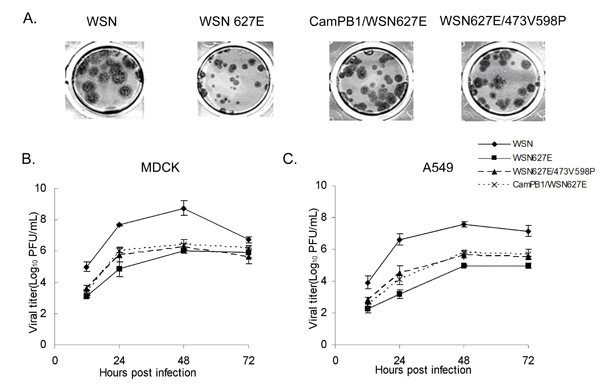Prof. SUN Bing with his team at Shanghai Institute of Pasteur, CAS, found that PB1 of avian influenza A virus contributes to higher polymerase activity than PB1 from human influenza A virus, and 473V and 598P are responsible for this role. This founding indicates a new mechanism for adaptation of avian influenza virus to humans.
The flu pandemic strains in 1918,1957,1968 and 2009, the human infected H5N1 influenza virus strain all contain avian–origin PB1. The function and mechanism of the avian PB1 in these strains are partially understood. We found that a PB1 subunit from an avian influenza virus (A/Cambodia/P0322095/2005 H5N1, Cam), enhanced polymerase activity of a human isolated attenuated virus A/WSN/33 carrying the PB2 K627E mutation (WSN627E) in vitro. Furthermore, we identified 473 valine (V) and 598 proline (P) in Cam PB1 as the residues responsible for this enhanced activity. The polymerase plays an important role in virus RNA replication and mRNA transcription. This founding indicates the role of PB1 in these pandemic strains, therefore suggests an explanation for the occurrences of these pandemic strains.
This research entitled " Amino acids 473V and 598P of PB1 from an avian origin influenza A virus contribute to polymerase activity especially in mammalian cells" was published in The Journal of General Virology on Nov. 16, 2011. This project was supported by grants from the European Union Sixth Framework Program, Ministry of Science and Technology,National Natural Science Foundation of China, the Chinese Academy of Sciences, Shanghai Pasteur Health Research Foundation, and Li Ka-Shing Foundation.
Amino acids 473V and 598P of PB1 from an avian origin influenza A virus contribute to polymerase activity especially in mammalian cells. (J Gen Virol. 2011 Nov 16. [Epub ahead of print])

Influenza A virus PB1 subunit could enhance WSN627E virus replication efficiency.
(A) Plaque assay of the recombinant virus and double mutated virus.
(B,C) The growth curves of these viruses.

